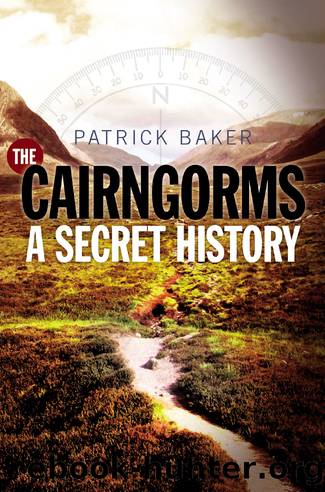The Cairngorms by Patrick Baker

Author:Patrick Baker
Language: eng
Format: epub
Publisher: Birlinn
Cairngorm place-names are imbued with significance, yet the modern name of the range itself is misleading. The etymology is simple but relatively recent in its derivation. In his authoritative book, Scottish Hill Names, Peter Drummond explains the difference between the ancient and the contemporary ways of referring to the massif. âIn Gaelic the range is known as Am Monadh Ruadh, the red-mountain land, from the pink colour of the granite that composes them. It became known universally in English as the Cairngorms in the last century, taking the name from this one rounded swell of a mountain that is prominent in the view from Speysideâ.
The change in name was significant, for in its literal translation it also described a change in colour for the range: Cairn Gorm means the blue (or green) hill. The renaming was unintentionally symbolic. The transition from being red mountains (their colour when seen close-up, intimately), to blue mountains (their colour when seen from a distance, from the outside), marked a time of transition in the region: an encroachment of external influences, the gradual demise of the indigenous Gaelic culture and a departure from the oral traditions that had defined many of the features within the range.
The ancient names in the Cairngorms are signs of ritual and relationship, of geology fusing with human history, landforms as way-markers and record-keepers, the begetters of stories and the focal-points of legends, âthat show,â as Nan Shepherd had observed, âhow old is manâs association with scaur and corrie: the Loch of the Thin Manâs Son, the Coire of the Cobbler, the Dairymaidâs Meadow, the Lurcherâs Crag.â
As is the case in other mountainous areas of Britain, some of the most evocative and enduring names in the Cairngorms relate not to peaks or valleys, but to the smallest of geological features. Often they are too small to be recorded on maps, but are instead retained in local consciousness in recognition that they distinguish parts of a wild place, so that they are handed down and reused in direction-giving and storytelling: a waterfall perhaps, or the confluence of two streams, the brow of a hill, or, more often than not, the singular occurrence of a distinctive stone or rock formation.
There are several instances of these mineral landmarks in the Cairngorms, each with their own significance or notoriety. The writer Ian Murray has retold the story of the Clach Thogalach, or the âStone of the Liftingâ that was once used as a challenge of strength for local men. The stone could, apparently, barely be lifted until one man outdid his peers with consummate ease, throwing the rock into the River Lui where it apparently rests to this day. High on the western side of Gleann Einich is the Argyll Stone, a pronounced outcrop of wind-rounded granite easily visible from across the glen. Legend has it that the stone takes its name from the Duke of Argyll, who in 1594 was sent to quell a rebellion of Catholic insurgents in Glenlivet. The Dukeâs forces were
Download
This site does not store any files on its server. We only index and link to content provided by other sites. Please contact the content providers to delete copyright contents if any and email us, we'll remove relevant links or contents immediately.
| General | Channel Islands |
| England | Northern Ireland |
| Scotland | Wales |
Spell It Out by David Crystal(36022)
Underground: A Human History of the Worlds Beneath Our Feet by Will Hunt(11997)
A Year in the Merde by Stephen Clarke(5298)
Venice by Jan Morris(2513)
Claridge's: The Cookbook by Nail Martyn & Erickson Meredith(2348)
My Paris Kitchen: Recipes and Stories by Lebovitz David(2230)
A TIME OF GIFTS by Patrick Leigh Fermor(2142)
The Plantagenets by Dan Jones(2023)
Welcome to the Goddamn Ice Cube by Blair Braverman(1982)
The Finnish Way by Katja Pantzar(1921)
From Russia with Lunch by David Smiedt(1920)
Top 10 Prague (EYEWITNESS TOP 10 TRAVEL GUIDES) by DK(1912)
Bang Poland: How To Make Love With Polish Girls In Poland by Roosh V(1909)
The Isle of Mull by Terry Marsh(1880)
A TIME TO KEEP SILENCE by Patrick Leigh Fermor(1850)
Rick Steves London 2018 by Rick Steves & Gene Openshaw(1811)
A Taste of Paris by David Downie(1800)
Insight Guides Experience Tokyo by Insight Guides(1767)
Merde in Europe by Stephen Clarke(1712)
